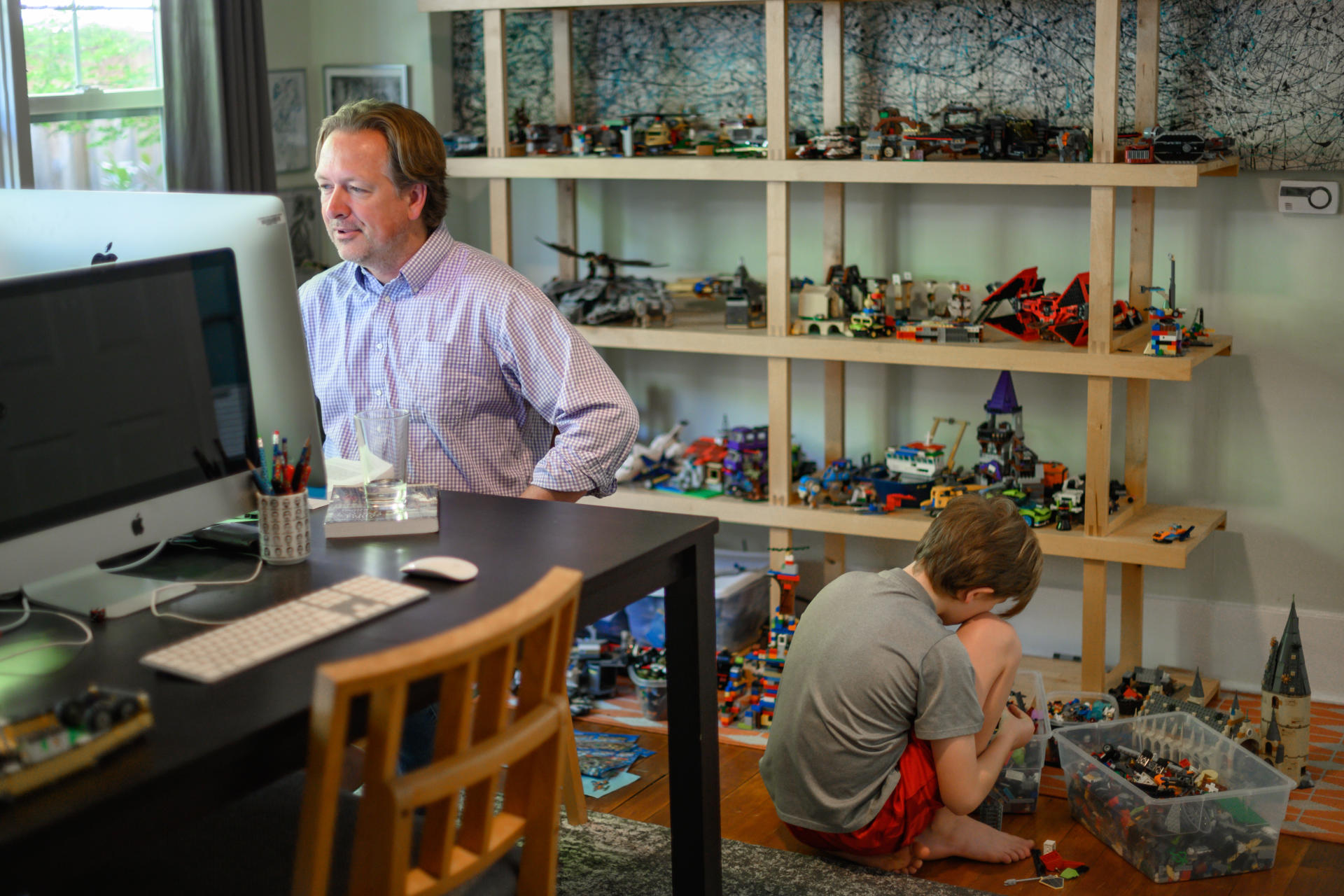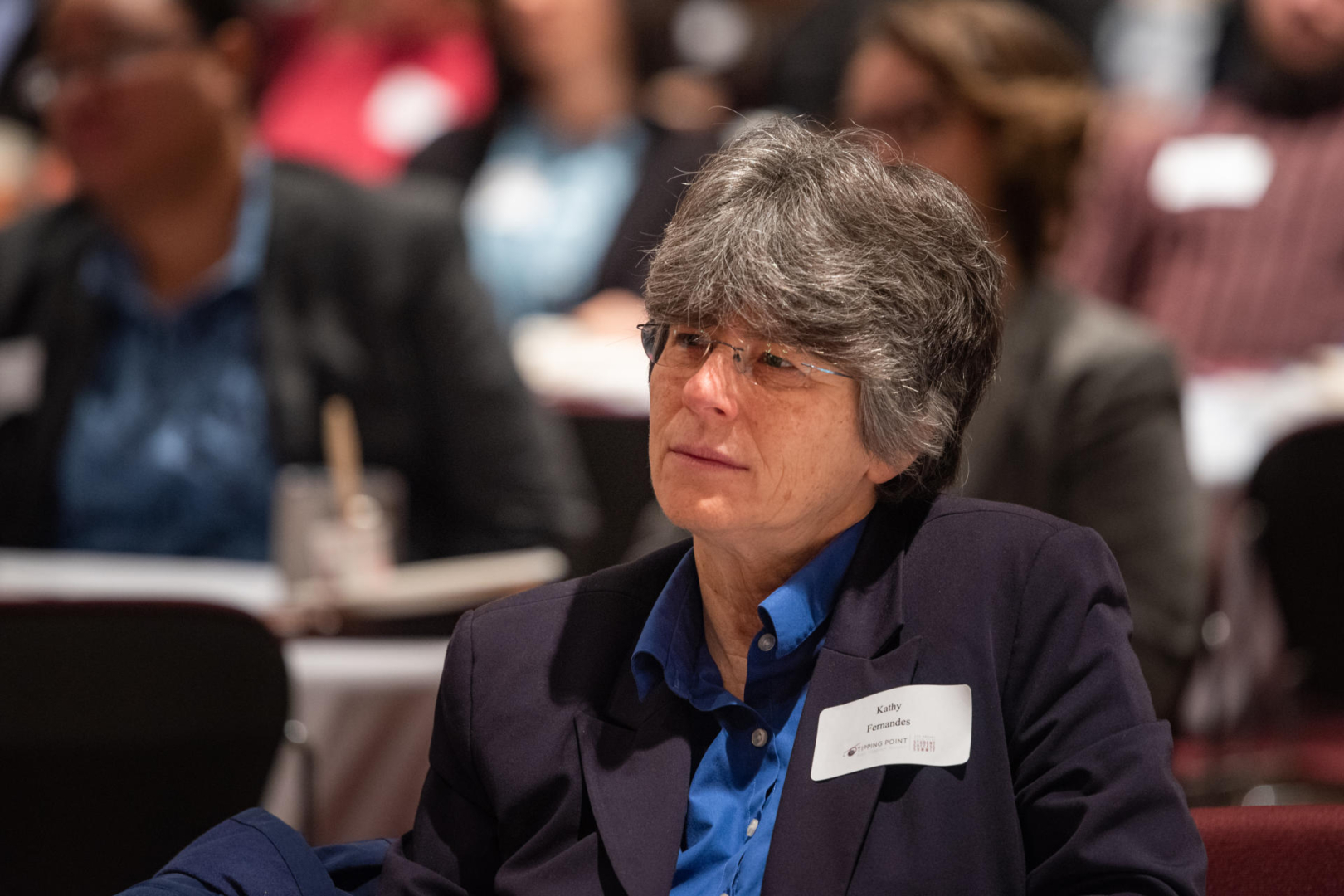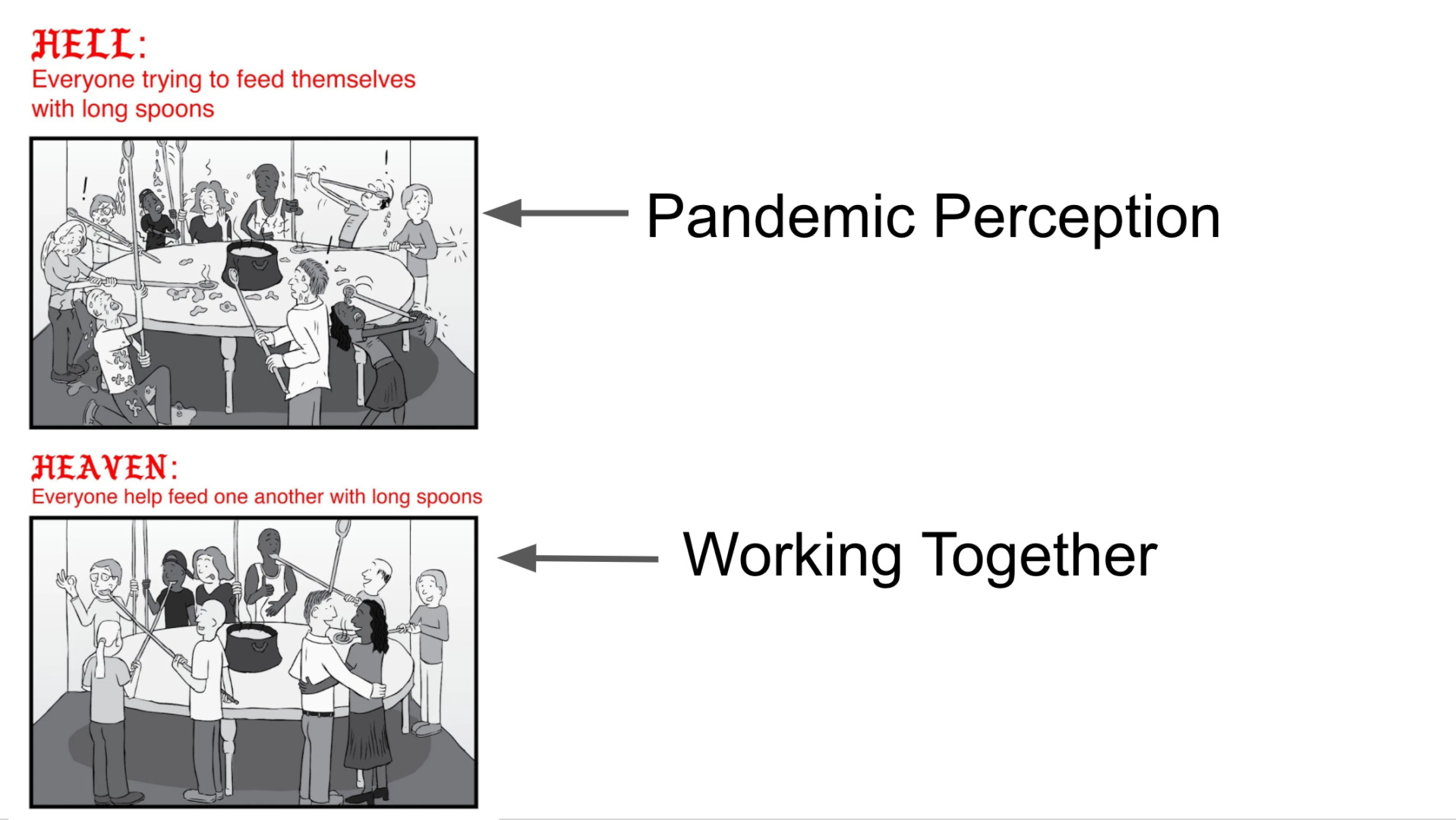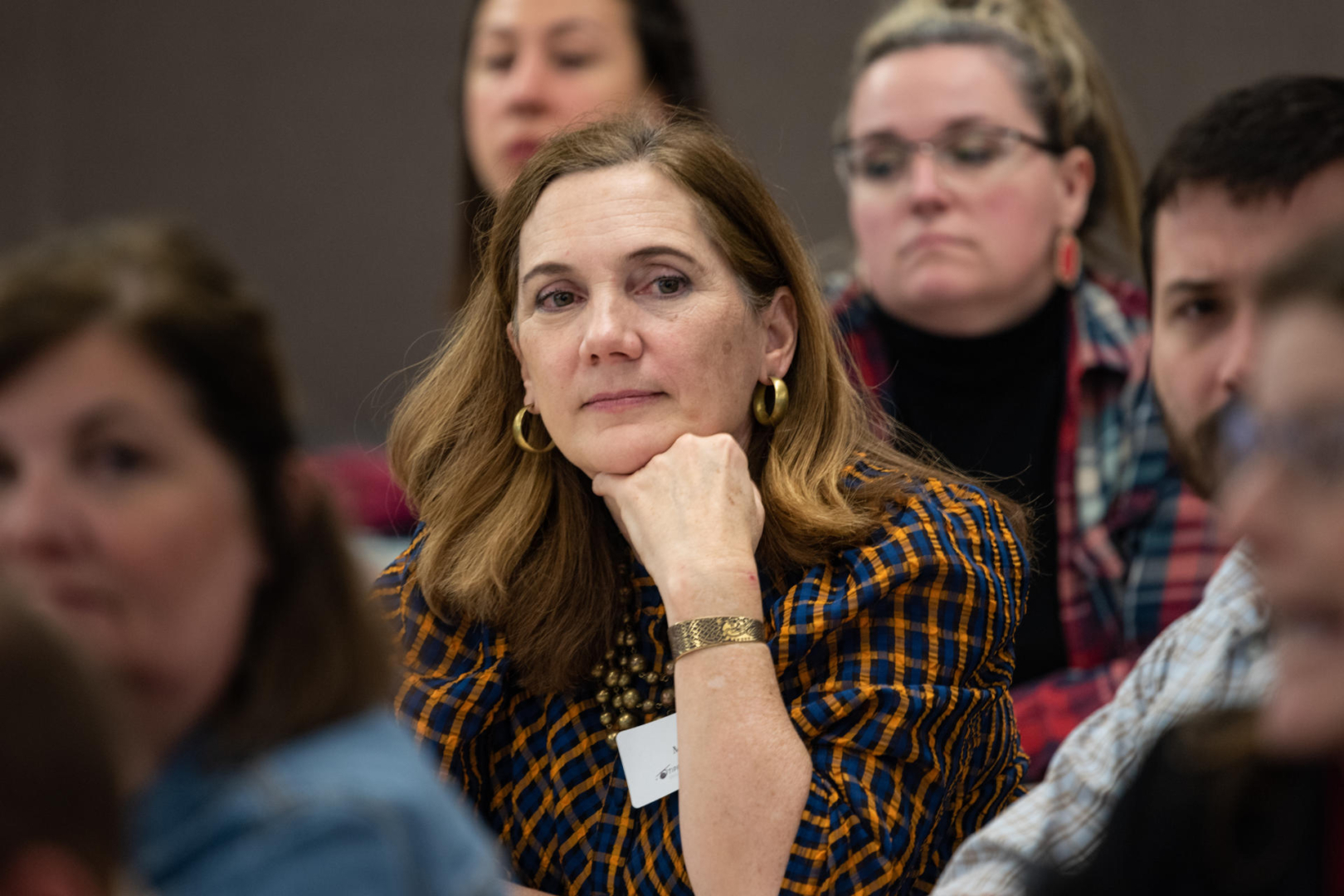Faculty Mentor Peers to Improve Virtual Teaching

Jason Nice (left) teaches his Early Modern History HIST 313 class online through Zoom while his son Henry (right), age 9, plays with Legos in their home on Monday, April 27, 2020 in Chico, Calif. The campus community adjusts to suspension of in-person instruction due to impacts of the coronavirus (COVID-19) pandemic. (Jason Halley/University Photographer/CSU, Chico)
Evidence of COVID-19’s disruption is everywhere. From employees working at home and restaurants temporarily closing to wearing masks and the now-ubiquitous social distancing measures, the pandemic has changed the way we live—and teach and learn.
When President Gayle Hutchinson announced on March 18 that the remainder of Chico State’s spring 2020 semester would move to online delivery, students’ lives were certainly upended, as they were asked to learn away from campus. Similarly, with little time to prepare, University faculty were asked to do something the vast majority of whom were not trained for—teach away from their classrooms.
“It’s important not to underestimate what a heavy lift this is for faculty,” said Dean of Undergraduate Education Kate McCarthy. “This is a big change for faculty who have never taught online.”
And the challenge continues. On May 12, CSU Chancellor Timothy White announced that all 23 campuses would move primarily to online instruction for the fall 2020 semester. But Chico State was already preparing for such a shift.
Weeks earlier, the University had begun to develop its own Go Virtual Summer Institute, a robust five-day training for faculty moving to online teaching coordinated by the University’s Technology and Learning Program (TLP). Demand among faculty was so high that a second training session had to be created. More than 350 faculty have signed up so far.
With just four Instructional Technology consultants, Academic Technology Officer Kathy Fernandes knew the need for help would quickly overwhelm her team. So the University coordinated its existing intellectual capital and tapped faculty with online teaching experience to become volunteer mentors.

“It’s this peer-mentor approach I think is really valuable,” McCarthy said, “that experienced faculty, whether they’re deeply invested in the pedagogy of their discipline or very experienced in online teaching, can bring that knowledge and experience to bear with their peers.”
Additionally, the institute emphasizes that quality face-to-face instruction and quality online instruction are more similar than different.
“Online instruction is built on the same principles of making a connection with your students, making the opportunity to learn equitable, and providing early and rich feedback—giving students an opportunity to engage in a variety of ways, so that all kinds of students feel the course material is related to them,” McCarthy said. “These are all things that we know make for good learning.”
Sarah Anderson, faculty in the Department of International Languages, Literatures, and Cultures, said when classes transitioned to distance learning in the spring, she attempted to keep her classes as similar to the first half of the semester as possible—while struggling with the reality that it was impossible for everything to be the same.
“The Go Virtual training opened my eyes to new tools, new ideas, and new ways to approach my teaching as I transition my classes online,” Anderson said. “With this fresh start for fall, it is the perfect time to get creative and dig deep to find new and innovative ways to engage with my students.”
Armed with new tools and new ideas, Anderson said she’s reminded of why she became an educator.
“I love the challenge of creating a learning environment for my students that promotes a sense of community, engagement and a shared purpose,” she said. “Thanks to Go Virtual, I am ready for an exciting fall semester.”

When the University moved to online instruction in the spring, Department of History faculty Jason Nice’s experience was not dissimilar to individuals across the country—with multiple people working and schooling under the same roof.
“I was an instructor teaching from home, my partner was another instructor teaching from home, and we’re parents of two children who were learning from home,” he said.
Now, Nice is leading a Go Virtual cohort of 19 faculty from the Departments of English, History, Philosophy, and Communication Arts and Sciences, as well as from the Honors Program. Working with faculty who are “committed to providing outstanding learning experiences for their students,” he said his experiences suggest that, with patience and empathy, instructors can foster a sense of community and connection, and create successful learning environments that balance structure and flexibility for students and themselves.
“My hope is that faculty will leave Go Virtual both with an awareness of the paramount importance of student engagement,” Nice said, “as well as having had the chance to learn, discuss, and practice strategies relevant to their class and discipline.”
Fernandes is familiar with this type of programming. Before returning to Chico State in August 2019—from 1988 to 2013 she was director of Academic Technology in Information Resources—she worked for the Chancellor’s Office, leading a program called Course Redesign with Technology (CRT). Developed as a way to battle enrollment bottlenecks that limit students’ ability to progress toward graduation, CRT employed now-familiar strategies such as online classwork, virtual labs, and hybrid course designs.
Wanting to give faculty more tools if virtual learning continued into fall, Fernandes used the CRT templates and developed the concept, ideas, and topics for the Go Virtual Institute. Organizers combed through survey data from students, faculty, and staff taken after the spring semester—reviewing what worked during the quick move to online delivery, as well as pinpointing trouble spots and areas ripe for improvement.
After getting buy-in from University deans and chairs, and final approval from Provost and Vice President for Academic Affairs Debra Larson, the Go Virtual Summer Institute opened its registration.

While faculty attendance is not mandatory, thanks to funding from multiple sources (including a CSU Course Redesign grant, the CARES Act, and University Foundation fundraising) participants are paid for their time.
Each session offers five days of instruction over Zoom with a different theme each day: “Quality Online Learning and Teaching,” “Assessment of Learning Outcomes,” “Equity, Diversity, and Inclusion,” “Student Learning and Faculty Cohorts,” and “Faculty Mentors, Cohort Summary, and Open Session.” Breakout sessions are held throughout the day, and TLP Summer Workshops are held on institute off-days, providing additional learning opportunities.
Additionally, each Zoom video session is archived, and additional resources are available to all faculty, including a TLP Live Zoom Support Room.
By working together in new, imaginative, and creative ways, the Go Virtual Summer Institute’s ultimate goal is to further enrich the experiences of Chico State students. The process begins with faculty, and whether they’re mentoring or being mentored, they are sure to be better prepared—even if they’re teaching online from their dining room, living room, or home office.
“It’s very, very difficult, and so I think this is the least we can do to support faculty in taking a minute to sit and think through in a deliberate way, ‘how can I do this, how can I do this well?’” McCarthy said. “I’m incredibly grateful to all the faculty who have stepped forward to take part in this, and I think it will make for a much better fall semester.”


